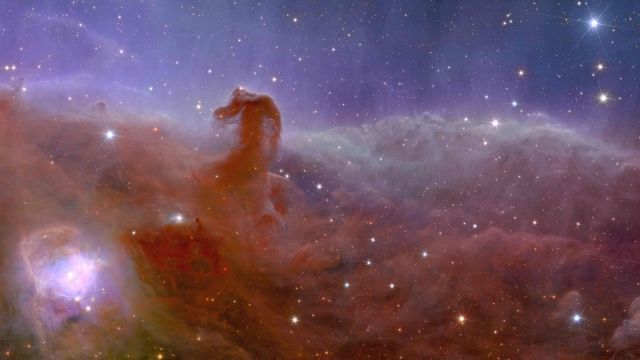Euclid mission for investigating dark matter & dark energy shares its first images
Here are the first images shared by the Euclid mission sent to investigate dark matter and energy.
 An image of the Horsehead Nebula captured by the Euclid mission. (ESA)
An image of the Horsehead Nebula captured by the Euclid mission. (ESA) The European Space Agency’s (ESA) Euclid mission, which launched in July this year to investigate the mystery of dark matter and dark energy, released its first five science images on Tuesday. They include views of large clusters with thousands of distant galaxies, close-ups of two nearby galaxies, a nebula, and a gravitationally bound group of stars called a globular cluster.
Euclid, ESA’s dark universe detective, was designed to investigate how dark matter and dark energy made the cosmos what it is. About 95 per cent of the universe seems to be made of these units that we have no idea about.
The reason we have no idea about them is because, as their names suggest, they are dark entities that we cannot directly detect. Instead, we have to rely on the subtle effects they have on the things that we can see. Over the next six years, Euclid will observe the shapes, distance and motions of billions of galaxies out to 10 billion light-years. In the process, it will create what ESA says is the largest cosmic 3D map ever made.
The images that you see below showcase that ability to a certain extent, capturing everything from bright stars to faint galaxies.
 The Perseus cluster imaged by the Euclid spacecraft. (ESA)
The Perseus cluster imaged by the Euclid spacecraft. (ESA)
The Perseus cluster
This image taken by Euclid shows 1,000 galaxies belonging to the Perseus Cluster. It also contains more than 100,000 galaxies that are further away in the background. Some of the fainter galaxies are so distant that their light took 10 billion light-years to reach Euclid. Scientists hope to map the distribution and shapes of these galaxies to find out more about how dark matter shapes the universe.
 The spiral galaxy IC 342 imaged by Euclid. (ESA)
The spiral galaxy IC 342 imaged by Euclid. (ESA)
The spiral galaxy IC 342
With its infrared view, the Euclid mission has helped reveal important information about the stars in IC 342, the spiral galaxy in the above image. In a lot of ways, it is a look-alike of the Milky Way.
 NGC 6822 captured by Euclid. (ESA)
NGC 6822 captured by Euclid. (ESA)
An irregular dwarf galaxy
Most galaxies in the universe don’t look like neat spirals, like IC 342 and the Milky Way. Instead, they are irregularly-shaped and small. They are the building blocks for bigger galaxies like our own, which is why it is interesting to study them. NGC 6822 is an irregular dark galaxy about 1.6 million light-years away from our planet.
 NGC 6397, a globular cluster. (ESA)
NGC 6397, a globular cluster. (ESA)
A globular cluster
Globular clusters are nearly globe-shaped clusters of hundreds or even thousands of stars that are held together tightly by gravity. NGC 6397, pictured here, is the second closest globular cluster to Earth and is about 7,8000 light-years away.
 The Horsehead Nebula. (ESA)
The Horsehead Nebula. (ESA)
The Horsehead nebula
Barnard 33, or the Horsehead Nebula as it is more popularly known, looks spectacular in this Euclid image. In this image, astronomers hope to find previously unseen Jupiter-mass planets that are in their infancy.







